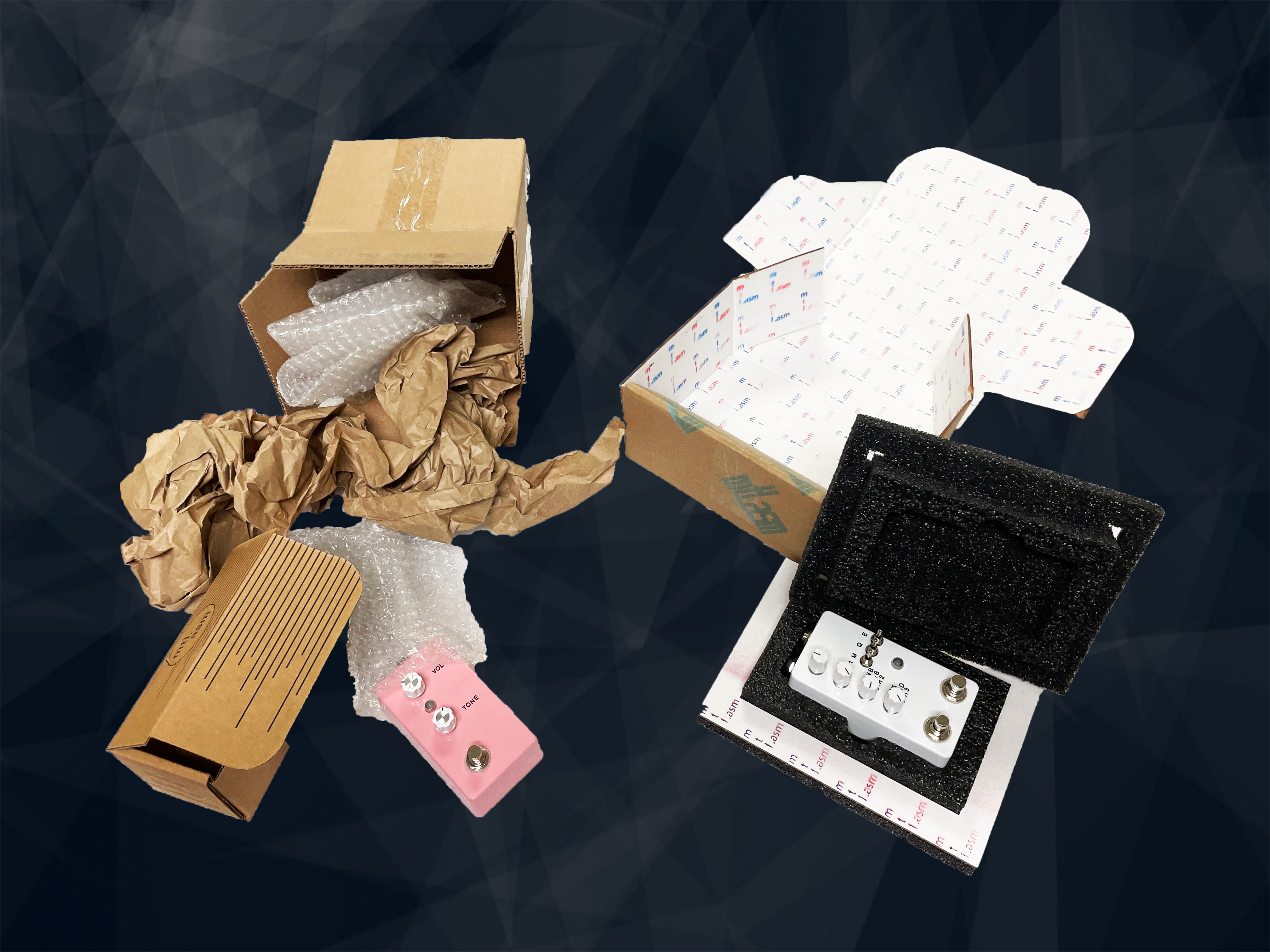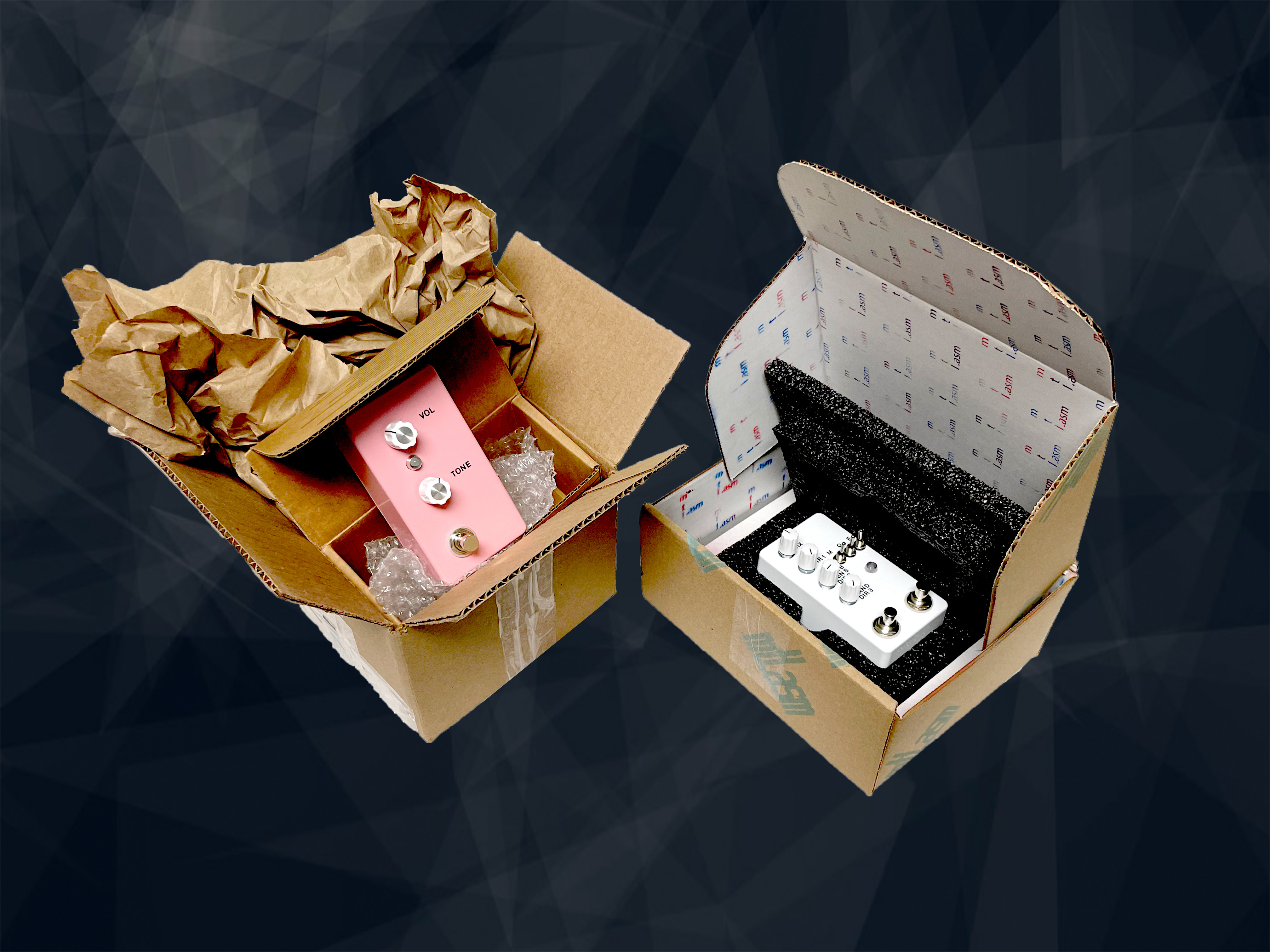Case Study: Ship in Own Container vs. Box in a Box
If you live in our world, the debate between ship in own container vs. box in a box packaging is a fierce, raging battle. If you’re normal, you don’t care - but you probably should, just a little.
With major carriers like Amazon, Walmart, and Target moving toward stricter sustainability requirements for all products, suppliers will soon need to pay attention to how they pack and ship their items.
This leads us to the purpose of this article: a comparison between the two most common methods of packing products.
What We Did
We were approached by Montreal Assembly, a guitar pedal manufacturer, who wanted to follow Amazon’s Frustration-Free Packaging Guidelines but did not currently do so. They wanted to switch to tap into the incentives Amazon offers compliant companies.
We saw this as a great opportunity to conduct an experiment comparing two packaging versions to see what results we found.
The current method Montreal Assembly used to ship their pedals was a box in box (BIB) version where the pedal is placed into a bag, which is then placed into a small box, which is then placed in a larger shipping container with loose dunnage paper and bubble.
Our engineers at Foam Industries then designed a new package - a ship in own container (SIOC) version where the pedal is supported by a custom foam insert placed in a single box. This version is compliant with Amazon’s Frustration-Free Packaging Guidelines.

We wanted to look at the following questions.
- How long did it take to pack the product?
- How much did the packaging weigh?
- What was the cost of the packaging?
- How effective was the BIB version at protecting the product?
- What is the customer’s unboxing perception?
- How much waste was produced in the packing and shipping process?
What We Learned: SIOC is Better
In our experiment, both methods were effective in terms of protecting the product. Both containers went through the shipping process without any damage.
However, we saw a huge difference in three key areas. In each, SIOC outperformed BIB. This wasn’t an entirely unexpected result - given that Amazon’s own research has shown the same - but we were still surprised by just how much better SIOC was in nearly every category.
More Efficient and Lower Cost
One of the most common reasons for choosing BIB is a perception that it costs less since you’re using cheaper void fill materials. However, when we conducted the experiment we found the opposite was true.
Cost for each version:
- BIB cost: $2.81
- SIOC cost: $2.76
The amount of material required to adequately protect our product in the BIB version was significantly more than the SOIC counterpart. Additionally, the BIB version weighs .58lbs while the SIOC version weighs .38lbs. The extra weight increased the overall cost to pack and ship.
Analyzing the above data, we realized that every 10,000 packages shipped using SIOC would save 2000 lbs (1 ton) of packaging material.
Finally, we discovered that the SIOC version took significantly less time to package. In our experiment, the time to package the BIB version was nearly twice as long as the SIOC version.
Life Cycle Analysis
We conducted an in-house LCA on both versions, and discovered that in nearly every area the SIOC version depleted fewer resources and created less waste.
Relative Results
The following charts show the relative indicator results of the respective project variants. For each indicator, the maximum result is set to 100% and the results of the other variants are displayed in relation to this result.
| Indicator | SIOC FFII Design | Box in a Box | Unit |
| Abiotic depletion | 1.89212e-7 | 3.80634e-7 | kg Sb eq |
| Abiotic depletion (fossil fuels) | 4.18175e+0 | 3.51681e+0 | MJ |
| Acidification | 8.98679e-4 | 8.92981e-4 | kg SO2 eq |
| Eutrophication | 2.83166e-4 | 5.03044e-4 | kg PO4--- eq |
| Fresh water aquatic ecotox. | 6.97154e-2 | 1.36521e-1 | kg 1,4-DB eq |
| Global warming (GWP100a) | 2.26113e-1 | 2.63432e-1 | kg CO2 eq |
| Human toxicity | 5.42218e-2 | 9.71423e-2 | kg 1,4-DB eq |
| Marine aquatic ecotoxicity | 3.12488e+2 | 5.98909e+2 | kg 1,4-DB eq |
| Ozone layer depletion (ODP) | 1.19458e-8 | 1.83814e-8 | kg CFC-11 eq |
| Photochemical oxidation | 4.70305e-5 | 5.18177e-5 | kg C2H4 eq |
| Terrestrial ecotoxicity | 6.05243e-4 | 1.19938e-3 | kg 1,4-DB eq |
The results showed that the SIOC version outperformed the BIB version in sustainability metrics across the board.
Improved Unboxing Experience
So far, all the numbers supported SIOC as the better option. However, we know how important the emotional aspect is as well for packaging. Customers are more likely to be loyal to a brand, more likely to repurchase, and more likely to purchase other products from the same brand when they have a positive unboxing experience.
Firstly, the process of actually getting the product out of the packaging was much, much simpler with the SIOC version. A customer opening the BIB version has to open the package, remove a bunch of void fill, open another box, and then finally open the bag containing the pedal. With the SIOC version, a customer only has to open one box. Our design affixed the foam insert to top and bottom of the box, which meant that when opening the pedal is revealed immediately.
In short - the SIOC version was an amazing unboxing experience. Easy to open, put the product on display, and even was photo-ready!
Final Results

Let’s go back to the questions we asked at the start of our experiment, and what we found.
How long did it take to pack the product?
BIB: 24 seconds
SIOC: 14 seconds
How much did the version weigh?
BIB: .58lbs
SIOC: .38lbs
What was the cost of the version?
BIB: $2.81
SIOC: $2.76
How effective was the version at protecting the product?
Both versions effectively protected the product.
How much effort did it take to unbox the product?
BIB: Moderate effort - No plastic or twist ties requiring special tools, but multiple layers of boxes and void fill to remove before reaching the product.
SIOC: Mild effort - Only one box to open to reach the product.
How much waste was produced in the packaging and shipping process?
See data in the “Life Cycle Analysis” section - SIOC produced less waste overall.
Our experiment was pretty clear - dollar for dollar, pound for pound, SIOC is the superior method.
Watch Our Video: Foam Industries Case Study: SIOC vs Box in a Box
Watch Vid version ->
As a leader in the packaging industry, Foam Industries has set the bar with an unwavering commitment to quality, exceptional client service, and constant innovation. Through our extensive inventory of endlessly customizable products, we ensure you find exactly what you’re looking for.
Foam Industries is a custom protective packaging company specializing in foam – with additional wood and plastic fabrication services. Our custom foam fabrication services are ideal for any type of packaging, display, or support service needed – from design to finished product
Get a Quote
Ensure your product(s) arrive from A to B, damage-free. Foam Industries will optimize your protective packaging. The results? Less damage, better bottom line.
